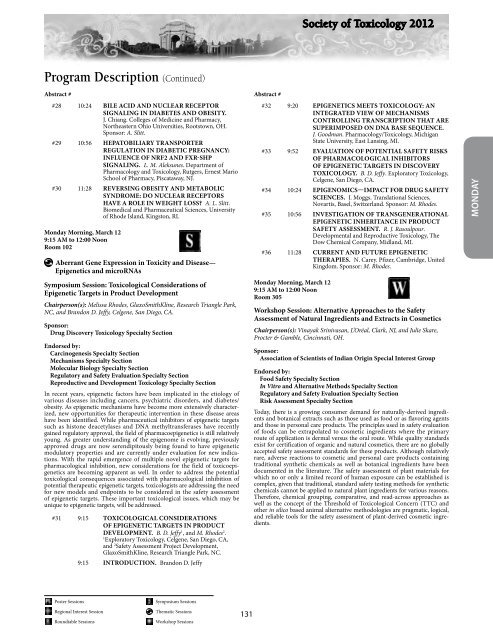Annual Meeting Program - Society of Toxicology
Annual Meeting Program - Society of Toxicology
Annual Meeting Program - Society of Toxicology
Create successful ePaper yourself
Turn your PDF publications into a flip-book with our unique Google optimized e-Paper software.
<strong>Society</strong> <strong>of</strong> <strong>Toxicology</strong> 2012<br />
<strong>Program</strong> Description (Continued)<br />
Abstract #<br />
#28 10:24 BILE ACID AND NUCLEAR RECEPTOR<br />
SIGNALING IN DIABETES AND OBESITY. <br />
J. Chiang. Colleges <strong>of</strong> Medicine and Pharmacy,<br />
Northeastern Ohio Universities, Rootstown, OH.<br />
Sponsor: A. Slitt.<br />
#29 10:56 HEPATOBILIARY TRANSPORTER<br />
REGULATION IN DIABETIC PREGNANCY:<br />
INFLUENCE OF NRF2 AND FXR-SHP<br />
SIGNALING. L. M. Aleksunes. Department <strong>of</strong><br />
Pharmacology and <strong>Toxicology</strong>, Rutgers, Ernest Mario<br />
School <strong>of</strong> Pharmacy, Piscataway, NJ.<br />
#30 11:28 REVERSING OBESITY AND METABOLIC<br />
SYNDROME: DO NUCLEAR RECEPTORS<br />
HAVE A ROLE IN WEIGHT LOSS? A. L. Slitt.<br />
Biomedical and Pharmaceutical Sciences, University<br />
<strong>of</strong> Rhode Island, Kingston, RI.<br />
Monday Morning, March 12<br />
9:15 AM to 12:00 Noon<br />
Room 102<br />
Aberrant Gene Expression in Toxicity and Disease—<br />
Epigenetics and microRNAs<br />
Symposium Session: Toxicological Considerations <strong>of</strong><br />
Epigenetic Targets in Product Development<br />
Chairperson(s): Melissa Rhodes, GlaxoSmithKline, Research Triangle Park,<br />
NC, and Brandon D. Jeffy, Celgene, San Diego, CA.<br />
Sponsor:<br />
Drug Discovery <strong>Toxicology</strong> Specialty Section<br />
Endorsed by:<br />
Carcinogenesis Specialty Section<br />
Mechanisms Specialty Section<br />
Molecular Biology Specialty Section<br />
Regulatory and Safety Evaluation Specialty Section<br />
Reproductive and Development <strong>Toxicology</strong> Specialty Section<br />
In recent years, epigenetic factors have been implicated in the etiology <strong>of</strong><br />
various diseases including cancers, psychiatric disorders, and diabetes/<br />
obesity. As epigenetic mechanisms have become more extensively characterized,<br />
new opportunities for therapeutic intervention in these disease areas<br />
have been identified. While pharmaceutical inhibitors <strong>of</strong> epigenetic targets<br />
such as histone deacetylases and DNA methyltransferases have recently<br />
gained regulatory approval, the field <strong>of</strong> pharmacoepigenetics is still relatively<br />
young. As greater understanding <strong>of</strong> the epigenome is evolving, previously<br />
approved drugs are now serendipitously being found to have epigenetic<br />
modulatory properties and are currently under evaluation for new indications.<br />
With the rapid emergence <strong>of</strong> multiple novel epigenetic targets for<br />
pharmacological inhibition, new considerations for the field <strong>of</strong> toxicoepigenetics<br />
are becoming apparent as well. In order to address the potential<br />
toxicological consequences associated with pharmacological inhibition <strong>of</strong><br />
potential therapeutic epigenetic targets, toxicologists are addressing the need<br />
for new models and endpoints to be considered in the safety assessment<br />
<strong>of</strong> epigenetic targets. These important toxicological issues, which may be<br />
unique to epigenetic targets, will be addressed.<br />
#31 9:15 TOXICOLOGICAL CONSIDERATIONS<br />
OF EPIGENETIC TARGETS IN PRODUCT<br />
DEVELOPMENT. B. D. Jeffy 1 , and M. Rhodes 2 .<br />
1<br />
Exploratory <strong>Toxicology</strong>, Celgene, San Diego, CA,<br />
and 2 Safety Assessment Project Development,<br />
GlaxoSmithKline, Research Triangle Park, NC.<br />
9:15 INTRODUCTION. Brandon D. Jeffy<br />
Abstract #<br />
#32 9:20 EPIGENETICS MEETS TOXICOLOGY: AN<br />
INTEGRATED VIEW OF MECHANISMS<br />
CONTROLLING TRANSCRIPTION THAT ARE<br />
SUPERIMPOSED ON DNA BASE SEQUENCE. <br />
J. Goodman. Pharmacology/<strong>Toxicology</strong>, Michigan<br />
State University, East Lansing, MI.<br />
#33 9:52 EVALUATION OF POTENTIAL SAFETY RISKS<br />
OF PHARMACOLOGICAL INHIBITORS<br />
OF EPIGENETIC TARGETS IN DISCOVERY<br />
TOXICOLOGY. B. D. Jeffy. Exploratory <strong>Toxicology</strong>,<br />
Celgene, San Diego, CA.<br />
#34 10:24 EPIGENOMICS—IMPACT FOR DRUG SAFETY<br />
SCIENCES. J. Moggs. Translational Sciences,<br />
Novartis, Basel, Switzerland. Sponsor: M. Rhodes.<br />
#35 10:56 INVESTIGATION OF TRANSGENERATIONAL<br />
EPIGENETIC INHERITANCE IN PRODUCT<br />
SAFETY ASSESSMENT. R. J. Rasoulpour.<br />
Developmental and Reproductive <strong>Toxicology</strong>, The<br />
Dow Chemical Company, Midland, MI.<br />
#36 11:28 CURRENT AND FUTURE EPIGENETIC<br />
THERAPIES. N. Carey. Pfizer, Cambridge, United<br />
Kingdom. Sponsor: M. Rhodes.<br />
Monday Morning, March 12<br />
9:15 AM to 12:00 Noon<br />
Room 305<br />
Workshop Session: Alternative Approaches to the Safety<br />
Assessment <strong>of</strong> Natural Ingredients and Extracts in Cosmetics<br />
Chairperson(s): Vinayak Srinivasan, L’Oréal, Clark, NJ, and Julie Skare,<br />
Procter & Gamble, Cincinnati, OH.<br />
Sponsor:<br />
Association <strong>of</strong> Scientists <strong>of</strong> Indian Origin Special Interest Group<br />
Endorsed by:<br />
Food Safety Specialty Section<br />
In Vitro and Alternative Methods Specialty Section<br />
Regulatory and Safety Evaluation Specialty Section<br />
Risk Assessment Specialty Section<br />
Today, there is a growing consumer demand for naturally-derived ingredients<br />
and botanical extracts such as those used as food or as flavoring agents<br />
and those in personal care products. The principles used in safety evaluation<br />
<strong>of</strong> foods can be extrapolated to cosmetic ingredients where the primary<br />
route <strong>of</strong> application is dermal versus the oral route. While quality standards<br />
exist for certification <strong>of</strong> organic and natural cosmetics, there are no globally<br />
accepted safety assessment standards for these products. Although relatively<br />
rare, adverse reactions to cosmetic and personal care products containing<br />
traditional synthetic chemicals as well as botanical ingredients have been<br />
documented in the literature. The safety assessment <strong>of</strong> plant materials for<br />
which no or only a limited record <strong>of</strong> human exposure can be established is<br />
complex, given that traditional, standard safety testing methods for synthetic<br />
chemicals cannot be applied to natural plant ingredients for various reasons.<br />
Therefore, chemical grouping, comparative, and read-across approaches as<br />
well as the concept <strong>of</strong> the Threshold <strong>of</strong> Toxicological Concern (TTC) and<br />
other in silico based animal alternative methodologies are pragmatic, logical,<br />
and reliable tools for the safety assessment <strong>of</strong> plant-derived cosmetic ingredients.<br />
MONday<br />
Poster Sessions<br />
Regional Interest Session<br />
Roundtable Sessions<br />
Symposium Sessions<br />
Thematic Sessions<br />
Workshop Sessions<br />
131
















